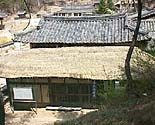Flag
  After an incident with a Japanese boat in 1872 and increased contact with other countries, the Korean government realized the need for a national symbol. The first flag was created in 1882 and over the years the design has varied. Banned during the Japanese occupation (1910-45), the present flag was created in 1948 for use by the South Korean government. The T'aegukki depicts the balancing philosophies of Yin/Yang and the concept of Ohaengsol (five directions). In the central circle, the red portion represents positive Yang, while the blue portion represents negative Yin. It is an ancient symbol representing balance and harmony. The combination of bars in each corner also symbolizes opposites and balance. The set in the upper left corner symbolizes heaven, spring, east, and gentility. The lower right corner symbolizes the earth, summer, west, and justice. The upper right corner symbolizes the moon, winter, north, and wisdom. The lower left corner symbolizes the sun, autumn, south, and courtesy. After an incident with a Japanese boat in 1872 and increased contact with other countries, the Korean government realized the need for a national symbol. The first flag was created in 1882 and over the years the design has varied. Banned during the Japanese occupation (1910-45), the present flag was created in 1948 for use by the South Korean government. The T'aegukki depicts the balancing philosophies of Yin/Yang and the concept of Ohaengsol (five directions). In the central circle, the red portion represents positive Yang, while the blue portion represents negative Yin. It is an ancient symbol representing balance and harmony. The combination of bars in each corner also symbolizes opposites and balance. The set in the upper left corner symbolizes heaven, spring, east, and gentility. The lower right corner symbolizes the earth, summer, west, and justice. The upper right corner symbolizes the moon, winter, north, and wisdom. The lower left corner symbolizes the sun, autumn, south, and courtesy.
|











waaaaw it's very nice..special in past, present and forever..no one can blame me..really unique culture and customs. actually what i conduct about it.. so small and bit..hope to travel to it,eager to see it and meet a lot of people grow up in it and spend limitless time with them to know real things about it not just articles or pictures ..
ReplyDeletetrying to go until die ..